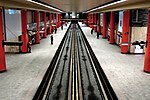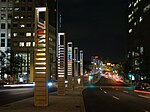Tour Intact
Downtown MontrealOffice buildings completed in 1974Skyscraper office buildings in CanadaSkyscrapers in Montreal

2020 Robert-Bourassa is a 104.0 m tall skyscraper located in Montreal, Quebec, Canada. It was built in 1974 and hosts a number of tenants, including Home Trust, Income Access, Intact Financial, and Monster.ca. The building previously served as the headquarters for Axa Canada, which comprised a number of subsidiaries of the French-based insurance company Axa, and was acquired by Intact in 2011.The building is located at 2020 Robert-Bourassa Boulevard between De Maisonneuve Boulevard & President Kennedy Ave, in Downtown Montreal. It is directly connected to the McGill Station of the Montreal Metro's Green Line.
Excerpt from the Wikipedia article Tour Intact (License: CC BY-SA 3.0, Authors, Images).Tour Intact
Rue Victoria, Montreal Ville-Marie
Geographical coordinates (GPS) Address External links Nearby Places Show on map
Geographical coordinates (GPS)
| Latitude | Longitude |
|---|---|
| N 45.504166666667 ° | E -73.572222222222 ° |
Address
2020 University
Rue Victoria
H3A 2A5 Montreal, Ville-Marie
Quebec, Canada
Open on Google Maps











